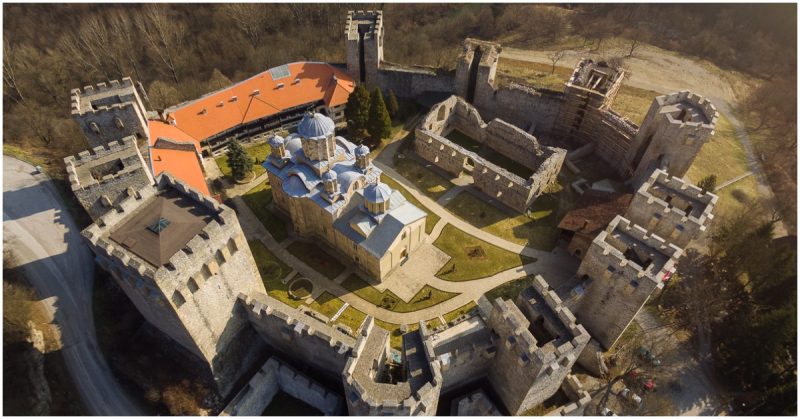Most people are familiar with the general history of the Arab expansion after the death of Mohammad. The Arabs didn’t sit idly in Saudi Arabia, they spread out in multiple directions. In the late 600s CE they dealt with the declining Sassanid Persian Empire to the east but faced a still mighty Byzantine Empire to the north and west. The massive clash between the vastly different cultures, one very old and one very new, would start with a bang at the battle of Yarmouk.
The talented general Khalid ibn al-Walid ran through most of modern Iraq and won great victories against the Persians there. The other Muslim armies fighting the Byzantines in the west had not been so lucky, suffering multiple minor setbacks.
When Khalid arrived in the Levant area comprising modern-day Israel and surrounding nations, he resumed his winning ways. He prevailed over a moderately-sized Byzantine army at the Battle of Ajnadayn and took the great city of Damascus without much effort. There didn’t seem to be an engagement that the Arabs couldn’t win.
The Byzantine Emperor Heraclius had only recently conquered much of the territory that the Arabs were now taking back. With the string of defeats piling up, the accomplished emperor decided on a full-scale invasion to crush the upstart invaders and methodically retake Byzantine territory.
This force contained roughly 100,000 men, a massive army for the time, but it was split into five parts with the aim to engage the scattered Muslim armies in separate battles and uniformly push them back into Saudi Arabia. The five divisions contained soldiers and commanders from all over: Franks, Armenians, Georgians and Christian Arabs among many others.
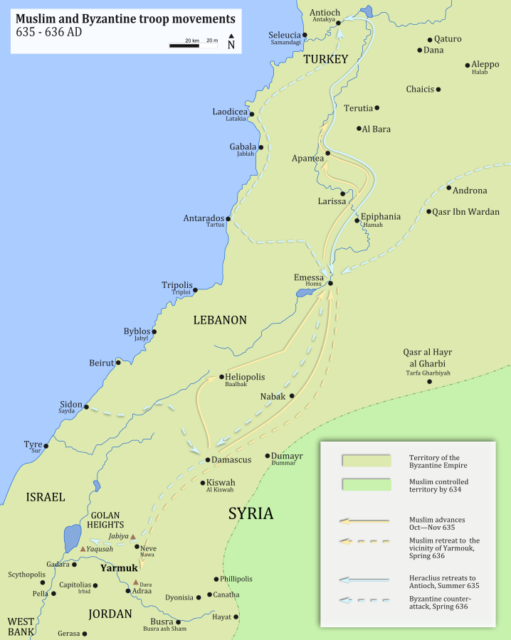
Despite having about half as many men as the Byzantines, Khalid wanted to consolidate his forces so they could fight one decisive battle. Despite the Byzantine’s misgivings, they had long since strategized to avoid large scale combat, the odds seemed too much in their favor to ignore. The five different groups combined and headed to the plains near Yarmouk.
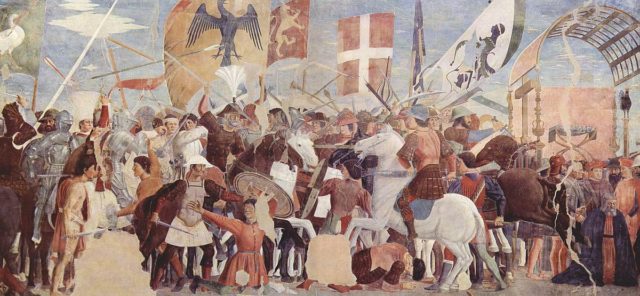
The two armies set up camp about a mile apart and began negotiations. During these weeks of negotiations, the Arabs received a steady stream of reinforcements from their home territory. While not a lot of men, most were established veterans, some even serving with Mohammad himself. The reinforcements arrived in steady streams prompting the Byzantines to start an attack for fear of even more Arab reinforcements.
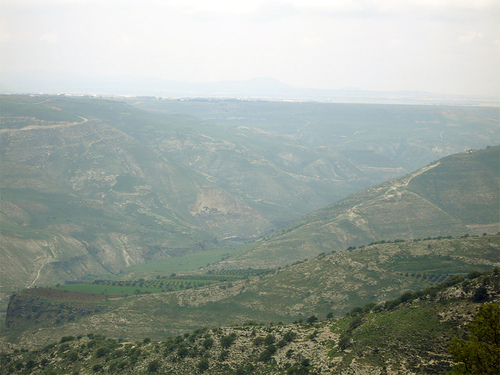
The battle commenced with both sides having a similar formation of deep infantry fronts and cavalry at the rear to prevent flanking. the battle has a few possibilities for how it unfolded, with some historians agreeing with the multi-day approach, and others maintaining that the whole affair was done in a few hours.
Presenting the multi-day possibility gives the best understanding of how the battle may have unfolded but it is possible that all the events happened much faster in a series of linked maneuvers.
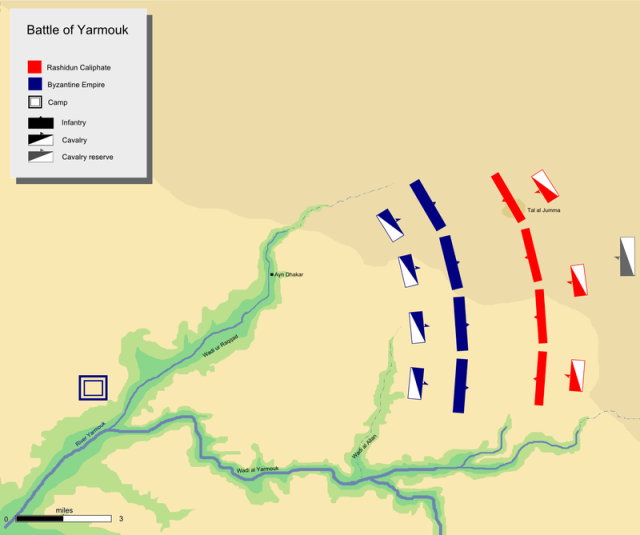
The first day saw limited skirmishing and supposedly individual fights by champions from either side. The Muslim records say that the Arab champions won the majority of these duels, but it is likely that they were even.
The next morning the Byzantine leaders decided on an early surprise attack with their full force, while sending the cavalry to put pressure on the flanks. A series of forward watches gave the Arabs more than enough time to get their army out in the same battle lines as the previous day. On the right flank, Khalid was able to send some of the guard units to stabilize that situation, but the Arab left was crumbling under the sheer numbers of advancing Byzantines.
The Arab men on the left began to flee back towards their camp in huge numbers, Arab cavalry counterattacks barely held the left flank as the infantry ran towards the camp. Here, however, they were greeted by their wives and the other women of the camp. These women of the camp gathered tent poles and other weapons and charged at their husbands shouting their disgust at the retreat. Some even
This unprecedented move greatly embarrassed the fleeing Arab infantry to the point that they turned and rejoined the battle. the battle lines stabilized and fierce Arab cavalry attacks forced the Byzantines on an orderly retreat back to their camp. The Byzantines were disappointed that a breakthrough had been so close but the day turned into a Byzantine retreat. The Arabs were overjoyed by holding their lines against the much larger army.
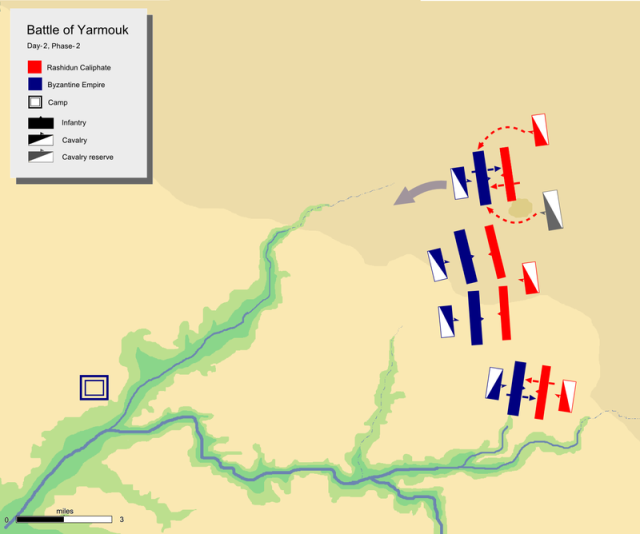
The next few days consisted of a dangerous series of moves where the Byzantines would push back a large section of the Arab lines and threaten to rout them. In response, Khalid would often personally lead cavalry charges against the flanks of the Byzantines that had become exposed by their pushing momentum. Several times the Arabs almost broke, but in turn inflicted multiple casualties on the Byzantines with efficient counter attacks.
Finally, on the sixth day, Khalid decided to mass all his cavalry behind his right infantry wing rather than the standard of dividing them on either side. When the battle commenced, the whole mass of Arabian cavalry swung around the Byzantine left flank. This aggressive move took the Byzantines by surprise and was all the more effective as the Byzantines had half of their cavalry on their right flank.
The Arab cavalry routed the Byzantine cavalry and swung around to collapse the Byzantine infantry. Steep ravines on the Byzantine right meant that their only route of escape was back through the enemy cavalry. This resulted in devastating casualties as the slower infantry desperately tried to flee.
This victory didn’t crush the Byzantine Empire as a whole, but certainly destroyed their power in the Middle East. Soon after Yarmouk, the Arabs seized Egypt and up to Armenia. Less than a century later the great city of Constantinople was besieged by the Arabs but here the Byzantines achieved the decisive victory.
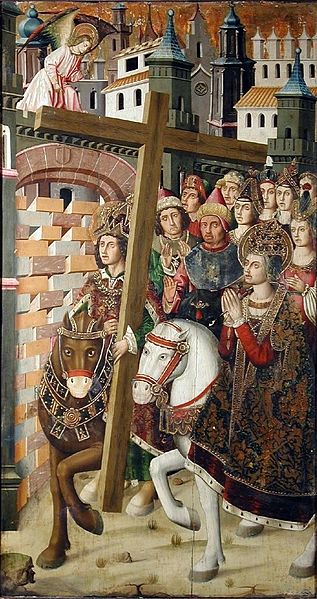
Had those camp women let their men flee the field, history certainly would have been very different. The Arabs could not muster a huge force to begin with, so their defeat at Yarmouk likely would have rendered them helpless to prevent the Byzantines from reconquering the Levant.
By William McLaughlin for War History Online
